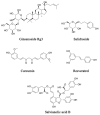Chinese Herbal Medicine for the Treatment of Depression: Effects on the Neuroendocrine-Immune Network
- PMID: 33466877
- PMCID: PMC7830381
- DOI: 10.3390/ph14010065
Chinese Herbal Medicine for the Treatment of Depression: Effects on the Neuroendocrine-Immune Network
Abstract
The neuroimmune and neuroendocrine systems are two critical biological systems in the pathogenesis of depression. Clinical and preclinical studies have demonstrated that the activation of the neuroinflammatory response of the immune system and hyperactivity of the hypothalamus-pituitary-adrenal (HPA) axis of the neuroendocrine system commonly coexist in patients with depression and that these two systems bidirectionally regulate one another through neural, immunological, and humoral intersystem interactions. The neuroendocrine-immune network poses difficulties associated with the development of antidepressant agents directed toward these biological systems for the effective treatment of depression. On the other hand, multidrug and multitarget Chinese Herbal Medicine (CHM) has great potential to assist in the development of novel medications for the systematic pharmacotherapy of depression. In this narrative essay, we conclusively analyze the mechanisms of action of CHM antidepressant constituents and formulas, specifically through the modulation of the neuroendocrine-immune network, by reviewing recent preclinical studies conducted using depressive animal models. Some CHM herbal constituents and formulas are highlighted as examples, and their mechanisms of action at both the molecular and systems levels are discussed. Furthermore, we discuss the crosstalk of these two biological systems and the systems pharmacology approach for understanding the system-wide mechanism of action of CHM on the neuroendocrine-immune network in depression treatment. The holistic, multidrug, and multitarget nature of CHM represents an excellent example of systems medicine in the effective treatment of depression.
Keywords: Chinese herbal medicine; HPA axis; depression; neuroendocrine system; neuroendocrine-immune network; neuroimmune system; neuroinflammation.
Conflict of interest statement
The authors declare no conflict of interest.
Figures




Similar articles
-
Potential therapeutic effects of Chinese herbal medicine in postpartum depression: Mechanisms and future directions.J Ethnopharmacol. 2024 Apr 24;324:117785. doi: 10.1016/j.jep.2024.117785. Epub 2024 Jan 21. J Ethnopharmacol. 2024. PMID: 38262525 Review.
-
Traditional Chinese Medicine in Depression Treatment: From Molecules to Systems.Front Pharmacol. 2020 May 7;11:586. doi: 10.3389/fphar.2020.00586. eCollection 2020. Front Pharmacol. 2020. PMID: 32457610 Free PMC article. Review.
-
Neurobiology of Chinese Herbal Medicine on Major Depressive Disorder.Int Rev Neurobiol. 2017;135:77-95. doi: 10.1016/bs.irn.2017.02.005. Epub 2017 Apr 6. Int Rev Neurobiol. 2017. PMID: 28807166 Review.
-
Role of Corticotropin Releasing Factor in the Neuroimmune Mechanisms of Depression: Examination of Current Pharmaceutical and Herbal Therapies.Front Cell Neurosci. 2019 Jul 2;13:290. doi: 10.3389/fncel.2019.00290. eCollection 2019. Front Cell Neurosci. 2019. PMID: 31312123 Free PMC article.
-
Antidepressant-like effects of Xiaochaihutang in a neuroendocrine mouse model of anxiety/depression.J Ethnopharmacol. 2016 Dec 24;194:674-683. doi: 10.1016/j.jep.2016.10.028. Epub 2016 Oct 13. J Ethnopharmacol. 2016. PMID: 27746334
Cited by
-
Molecular basis and mechanism of action of Albizia julibrissin in depression treatment and clinical application of its formulae.Chin Herb Med. 2023 Mar 15;15(2):201-213. doi: 10.1016/j.chmed.2022.10.004. eCollection 2023 Apr. Chin Herb Med. 2023. PMID: 37265761 Free PMC article. Review.
-
Efficacy of Chinese herbal medicine in the treatment of anxiety and depression in male sexual dysfunction: a systematic review and meta-analysis.Sex Med. 2025 Jul 10;13(3):qfaf048. doi: 10.1093/sexmed/qfaf048. eCollection 2025 Jun. Sex Med. 2025. PMID: 40641608 Free PMC article. Review.
-
Recuperative herbal formula Jing Si maintains vasculature permeability balance, regulates inflammation and assuages concomitants of "Long-Covid".Biomed Pharmacother. 2023 Jul;163:114752. doi: 10.1016/j.biopha.2023.114752. Epub 2023 Apr 26. Biomed Pharmacother. 2023. PMID: 37116351 Free PMC article.
-
Antidepressant Potential of Quercetin and its Glycoside Derivatives: A Comprehensive Review and Update.Front Pharmacol. 2022 Apr 8;13:865376. doi: 10.3389/fphar.2022.865376. eCollection 2022. Front Pharmacol. 2022. PMID: 35462940 Free PMC article. Review.
-
The Effect of Herbal Medicine on Suicidal Behavior: A Protocol for Systematic Review and Meta-Analysis.Healthcare (Basel). 2023 May 11;11(10):1387. doi: 10.3390/healthcare11101387. Healthcare (Basel). 2023. PMID: 37239673 Free PMC article.
References
-
- WHO Depression. [(accessed on 30 January 2020)]; Available online: https://www.who.int/news-room/fact-sheets/detail/depression.
Publication types
Grants and funding
LinkOut - more resources
Full Text Sources
Other Literature Sources

